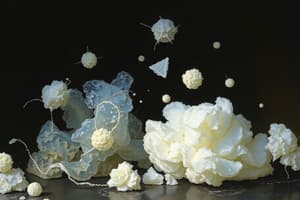Podcast
Questions and Answers
Which of the following describes a physical change?
Which of the following describes a physical change?
- Fruit rotting
- Ice melting into water (correct)
- Rust forming on iron
- A cake baking in the oven
A solute is the liquid in which a solute dissolves.
A solute is the liquid in which a solute dissolves.
False (B)
What is the freezing point of water in degrees Celsius?
What is the freezing point of water in degrees Celsius?
0°C
When a solid dissolves in liquid, it forms a ______.
When a solid dissolves in liquid, it forms a ______.
Match the following terms with their definitions:
Match the following terms with their definitions:
Which of the following scenarios represents a chemical change?
Which of the following scenarios represents a chemical change?
Evaporation decreases with increase in wind speed.
Evaporation decreases with increase in wind speed.
What happens when raw egg is boiled?
What happens when raw egg is boiled?
A mixture where two or more substances are combined without changing their properties is called a ______.
A mixture where two or more substances are combined without changing their properties is called a ______.
What is an example of a factor affecting the rate of evaporation?
What is an example of a factor affecting the rate of evaporation?
Flashcards
Physical Change
Physical Change
A change in a substance that alters its appearance but not its chemical composition. The substance can be returned to its original form.
Chemical Change
Chemical Change
A change in a substance that results in the formation of a new substance with different chemical properties. It cannot be reversed easily.
Mixture
Mixture
A combination of two or more substances where each substance retains its individual properties.
Solution
Solution
Signup and view all the flashcards
Solute
Solute
Signup and view all the flashcards
Solvent
Solvent
Signup and view all the flashcards
Suspension
Suspension
Signup and view all the flashcards
Freezing Point
Freezing Point
Signup and view all the flashcards
Evaporation
Evaporation
Signup and view all the flashcards
Factors Affecting Evaporation
Factors Affecting Evaporation
Signup and view all the flashcards
Study Notes
Changes in Matter
- Matter can experience physical or chemical changes.
- Physical changes allow a substance to revert to its original form, unlike chemical changes.
- Mixtures form when two or more substances combine without changing their properties
- A homogeneous solution occurs when a solid dissolves completely in a liquid, creating a uniform mixture where the components are indistinguishable.
- Examples include salt and water.
- A heterogeneous mixture has visibly different components, like a mixture of oil and sand.
- Types of heterogeneous mixtures include solutions, suspensions, and colloids.
- Examples include salt water, egg and water, eg. milk
- Types of heterogeneous mixtures include solutions, suspensions, and colloids.
States of Matter and Changes
- Matter exists in three states: solid, liquid, and gas.
- Changes of state include melting, solidification, vaporization, liquefaction, deposition.
- Sublimation: A solid changing directly to a gas without becoming a liquid.
- Melting: A solid changing to a liquid when heated.
- Solidification: A liquid solidifying into a solid when cooled.
- Vaporization: Change from liquid to gas.
- Liquefaction: Gas changing to liquid
- Deposition: Gas changing into solid
Factors Affecting Changes
- Temperature affects the rate of phase changes.
- Wind speed influences evaporation rates.
- Exposed surface area impacts evaporation.
- Chemical changes result in a new substance with different properties. Examples of chemical changes include rust forming on iron and eggs cooking.
- Changes in color, formation of bubbles and precipitate are indicators of chemical or physical changes.
- Precipitate: A substance that is deposited as a solid from a solution. This often indicates a chemical change.
Additional Points
- Water freezes to form ice at 0°C (freezing point).
Studying That Suits You
Use AI to generate personalized quizzes and flashcards to suit your learning preferences.




